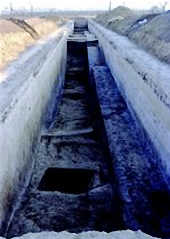 Location: Suburbs of Zhengzhou, capital of Central China's Henan Province
Location: Suburbs of Zhengzhou, capital of Central China's Henan Province
Period:Xia Dynasty(2100-1600BC)
Excavation period: March 2002-December 2003
The Zhengzhou Municipal Cultural Relics Archeological Research Institute, led by Wang Wenhua
 Findings
Findings
From March 2002 to December 2003, the Zhengzhou Municipal Cultural Relics Archeological Research Institute Zhengzhou was busy excavating Dashigu City. The site was discovered in the suburbs of Zhengzhou, capital of Central China's Henan Province. Archaeologists have confirmed that the Dashigu cultural relics of the Xia Dynasty date back to the mid and late Erlitou Culture, which was part of the Bronze Age (21st century-17th century BC).
The flat, rectangular site consists of two parts: the city wall and moat. Most parts of the city wall were discovered nearly 1 meter below the earth's surface. City wall relics were constructed of several layers of soil, suggesting that the wall was either renewed or restored on several occasions. The two moats, which run parallel, are 2-2.8 meters deep.
Foundations, tombs, ash pits and ash ditches were discovered inside the site, mainly from the second, third and early fourth phase of the Erlitou Culture. Large quantities of earthen drainpipe fragments were also found in the ash ditches.
What interests archeologists most is a ring moat from the early Shang Dynasty(1600-1100BC) that lies between the city wall and the moats of the Xia Dynasty, running parallel to the Xia moats. Abundant remains from the early Shang Dynasty were also discovered inside the ring moat, which suggests that the city remained an important residential settlement during that period.
